There’s something special about cats with bright blue eyes that capture our attention. While all kittens are born with blue eyes, only some cat breeds retain their blue-eyed trait into adulthood. This is often due to genetics, such as pointed coat patterns or albinism genes lacking pigment in the iris.
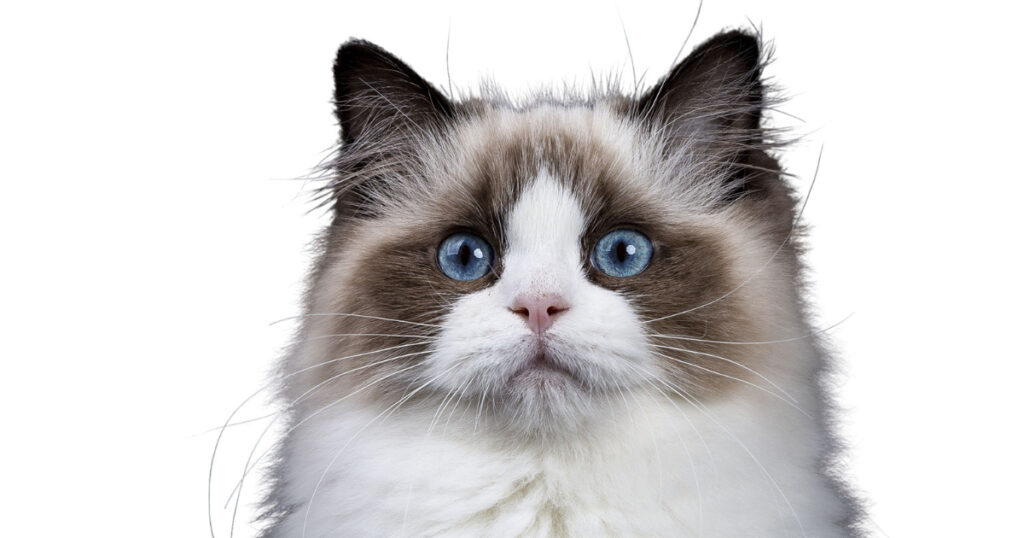
If you’ve been captivated by cats with sapphire eyes, you’ll want to learn more about the various breeds that commonly exhibit this feature. Let’s explore some of the most popular blue-eyed cat breeds and what makes their azure eyes so alluring.
Siamese
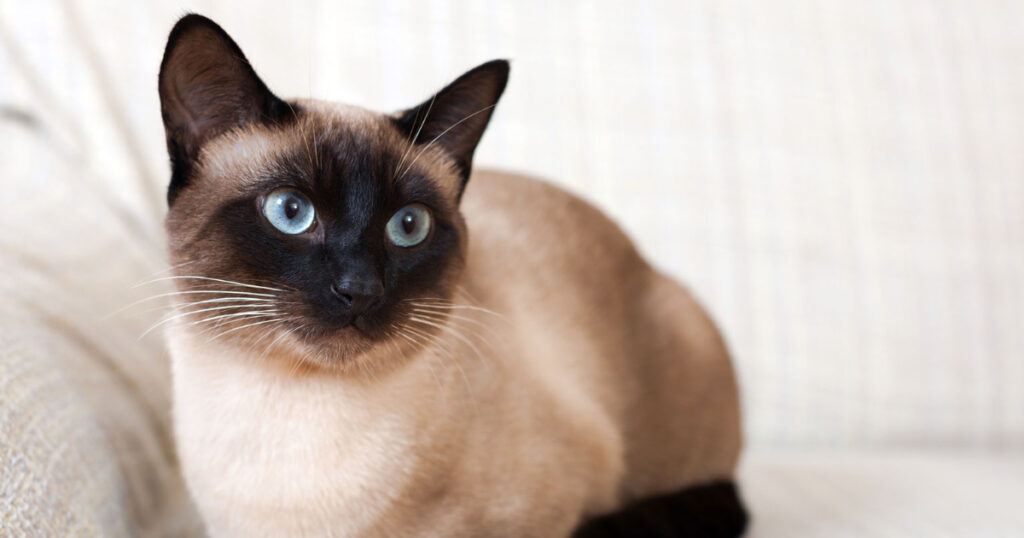
The Siamese is likely the first breed you think of for cats with blue eyes. This ancient breed originated in Thailand, where they were revered and considered sacred.
All Siamese cats have striking blue almond-shaped eyes due to a form of partial albinism. Their pointed coat pattern with darker coloration on the face, ears, legs, and tail is also tied to this albinism gene. Siamese come in four different point colors: seal, chocolate, blue, and lilac.
These vocal, affectionate cats thrive on human interaction and don’t like to be left alone. Their melodic voices and emotive cries for attention, when ignored, make the Siamese one of the most talkative breeds. Those mesmerizing blue eyes seem to stare right into your soul!
Balinese

Closely related to the Siamese, the Balinese originated as a natural long-haired mutation of the Siamese breed. Aside from their silky, flowing fur, the Balinese share the same pointed coat colors and vivid blue eyes as the Siamese.
Named after the graceful dancers of Bali, this cat is lithe and athletic. Balinese are highly intelligent and curious. They remain very attached to their owners and are playful and gentle companions. The Balinese express themselves vocally like the Siamese, so be prepared for an opinionated, communicative cat.
Birman

The Birman has an air of mystery, with fanciful stories of its origins involving temple cats in Burma. Today’s Birman breed emerged from crosses between Siamese and Persian cats. This cat with blue eyes always has four white paws called “gloves.”
Birmans have semi-long, silky fur that doesn’t mat. Their coat comes in seal, chocolate, blue, lilac, red, cream, and other pointed colors. Despite their luxurious appearance, Birmans require minimal grooming. These cats tend to be calm, sweet-natured, and thrive on companionship.
Ragdoll

One glimpse of a Ragdoll‘s sparkling sapphire eyes, and it’s easy to see why they are one of the most popular pedigreed cats today. Ragdolls are praised for their ultra-plush, long fur and laidback personality.
Ragdolls earned their name because they tend to go limp when held. They make wonderful lap cats and don’t mind being carried around. These large, gentle cats come in various pointed colors with or without white markings. Oval-shaped blue eyes in deeper shades give Ragdolls an exceptionally dreamy look.
Snowshoe
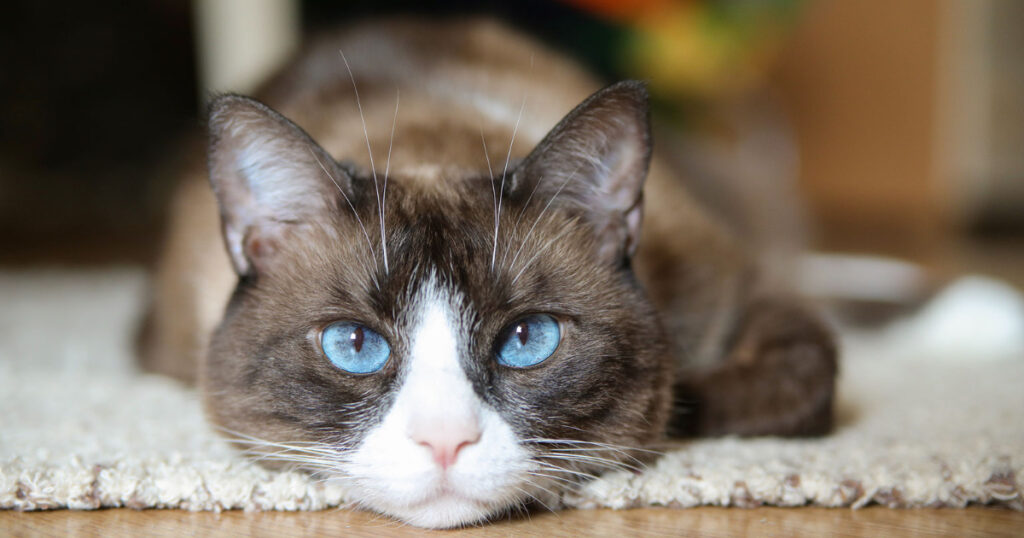
With their cute white “boots” and striking facial markings, Snowshoes captivate with their vivid blue eyes. Snowshoes were first created in the 1960s by crossing Siamese with American Shorthairs. As a pointed breed, Snowshoes exhibit darker coloration on the ears, face, tail, and legs.
Playful and affectionate, Snowshoes inherited the talkative trait of the Siamese. Provide plenty of toys and interaction to keep these cats entertained. Their blue eyes appear wide-set above a cute white muzzle and mask-like face. Snowshoes require daily brushing to maintain their short or medium-length coats.
Himalayan

The Himalayan, also called the Colorpoint Persian, combines the best features of the Siamese and Persian breeds. Himalayans have the point coloration of the Siamese on a fluffy Persian body. Their bright blue eyes and smushed facial features give them a sweet expression.
Bred as lap cats, Himalayans seek out human attention and petting. They love lounging around the house. But their long, thick fur requires extensive grooming to avoid tangles and mats. Himalayans come in seal point, chocolate point, blue point, lilac point, and other colors.
Javanese
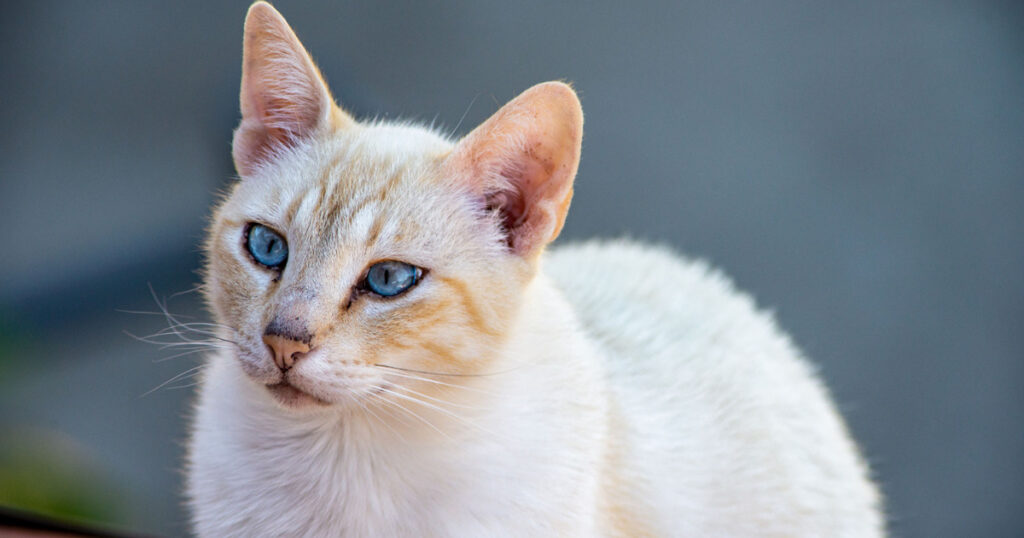
With their vivid blue eyes and pointed pattern, the Javanese resemble a long-haired Siamese. Javanese cats descended from crossing Balinese, Siamese, and Colorpoint Shorthair breeds. They are sometimes considered a division of the Balinese breed.
Like the Siamese and Balinese, Javanese cats are highly vocal and love conversing with their owners. These active, playful cats thrive with lots of interaction and mental stimulation. The Javanese’s medium-long fur only needs weekly brushing. Lynx points, tortoiseshell, and various color points are seen in the Javanese.
Colorpoint Shorthair

The Colorpoint Shorthair shares a Siamese body and blue eyes. But as the name suggests, this breed comes in many more “point” colors besides the traditional Siamese seal, chocolate, blue and lilac points. Breeding Siamese cats with red tabby American Shorthairs introduced additional point colors.
Energetic and intelligent like the Siamese, the Colorpoint Shorthair needs interactive play and puzzles to engage their active minds. They closely bond with their owners and don’t like to be ignored. Their short fur is easy to groom a few times a week. Be prepared for an outgoing, chatty companion with this breed.
Tonkinese
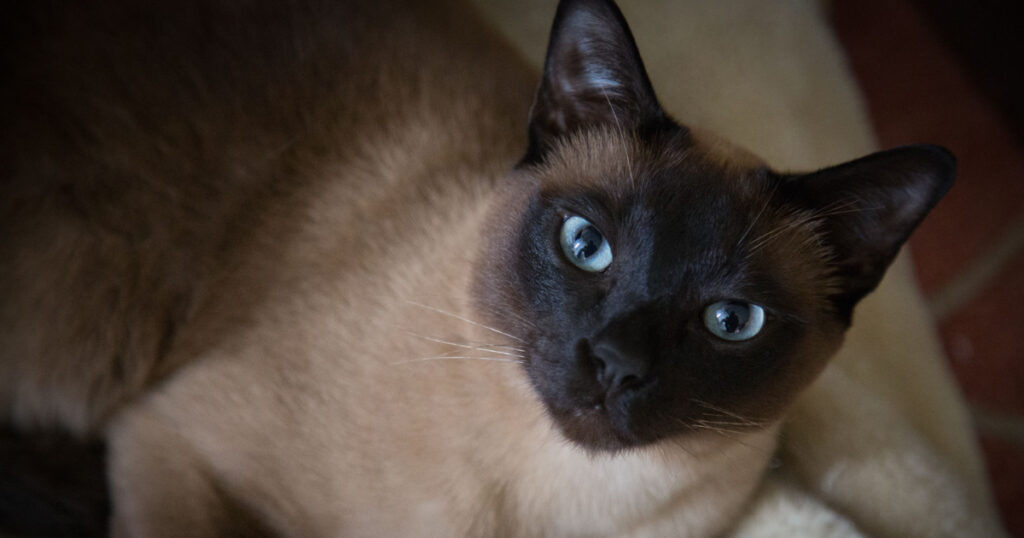
A cross between Siamese and Burmese resulted in a breed that exhibits traits of both. Their bodies are less slender than the Siamese. And their blue-green eyes shimmer between the vivid Siamese blue and aqua Burmese tones depending on coat color.
Tonkinese have playful, affectionate personalities. They get along well with kids and other pets when socialized young. These cats love climbing high perches, so a tall cat tree is necessary. Champagne, platinum, natural and blue make up the Tonkinese’s coat colors. Expect happy chirps and trills from this vocal breed.
Turkish Angora

The Turkish Angora is considered a national treasure in its native Turkey, with a history of thousands of years. While this shimmery-coated breed often has blue eyes, eye colors can also include amber, green, and odd-eyed.
Although all white Turkish Angoras may be prone to deafness, those with other coat colors and patterns and blue eyes retain normal hearing. Clever and energetic, Turkish Angoras need interactive play and puzzle toys to engage their agile minds. These cats bond closely with their families.
Turkish Van
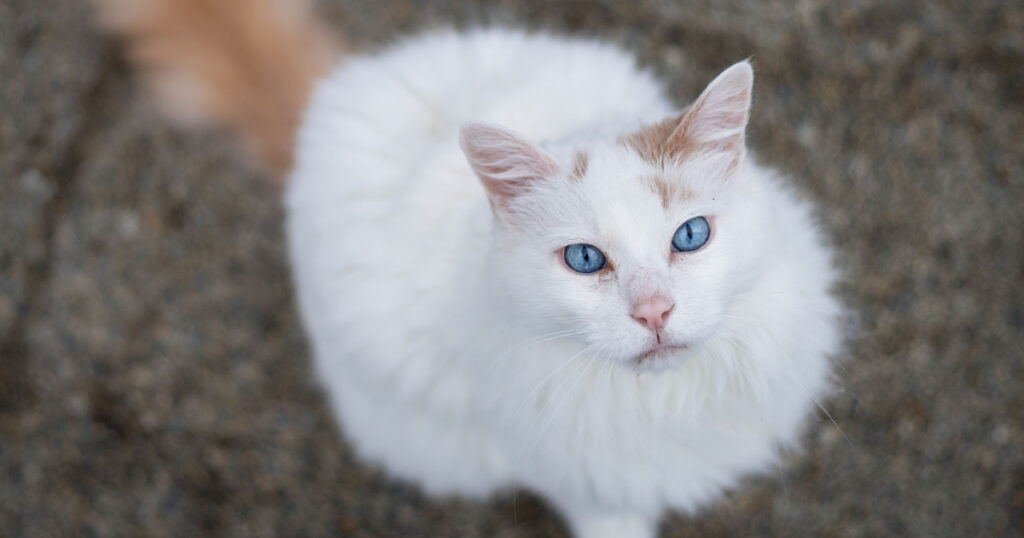
Hailing from the Lake Van region of Turkey, the Turkish Van is another ancient breed that frequently has blue eyes. They are born with blue eyes that change to amber or stay blue by adulthood. Turkish Vans with two different eye colors also occur.
These cats have a unique color pattern with minimal white spotting except on the head and tail. Unlike most cats, their semi-long, water-resistant coat enables Turkish Vans to swim and play in the water. Intelligent and energetic, expect an outgoing, fun-loving companion when you adopt a Turkish Van.
Ojos Azules
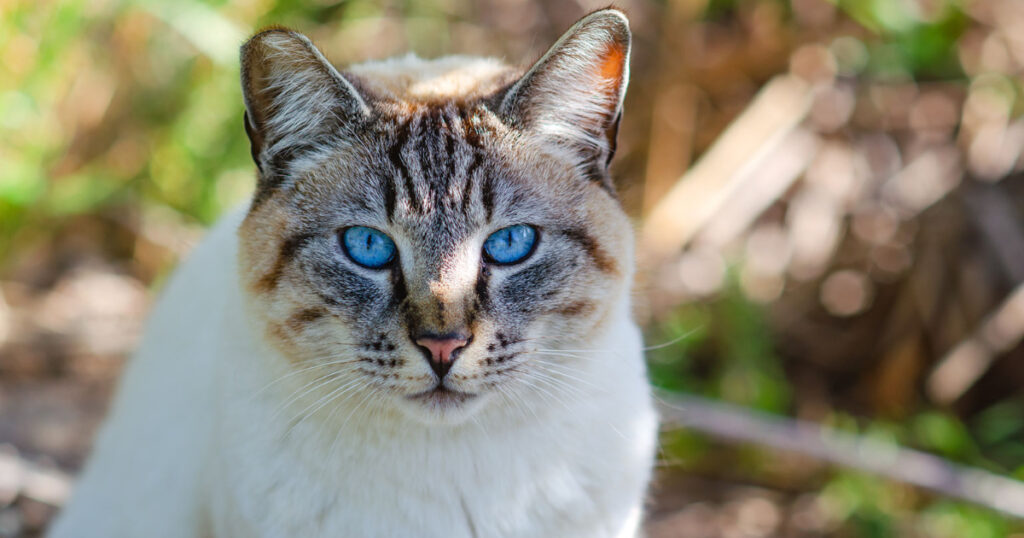
Ojos Azules translates from Spanish as “blue eyes,” an apt description for this rare breed’s dazzling peepers. Unlike white-coated cats, this breed’s blue eyes aren’t linked to deafness. Ojos Azules also exhibit eye color unrelated to coat color. For instance, these cats can have deep blue eyes and a black coat.
The Ojos Azules began in the 1980s and remain incredibly scarce. But those who have interacted with these cats describe them as highly intelligent, energetic, and affectionate. Their eye color ranges from pale ice blue to vivid sapphire. Ojos Azules have short, plush coats that come in almost any color and pattern except solid white.
Other Breeds
Other pedigreed cats and mixed breeds may occasionally have blue eyes, depending on their lineage. For example, some Siamese mixes inherit the Siamese blue eyes and pointed coat traits.
White cats of any breed are more apt to have blue eyes due to the gene that causes their white coloring, limiting the melanin pigment responsible for eye color.
Although less common, breeds like the Persian, Exotic Shorthair, and British Shorthair can produce blue-eyed kittens. Blue eyes remain a unique and admired feature among cats across many breeds.
Why Do Cats Have Blue Eyes?
You may wonder why some cats have blue eyes while others do not. It comes down to genetics, precisely how much melanin pigment an individual cat inherits.
Melanin is produced by cells called melanocytes located in the iris, the colored part of the eye. The more melanocytes present, the darker the eye color.
For example, amber, yellow, and green eyes have abundant melanin. Blue eyes indicate low levels of melanin. Albino cats lack entirely melanin.
Kittens start with minimal melanin, explaining their blue eyes at birth. As they mature, melanin increases, causing eye color to intensify.
But certain breeds either wholly or partially lack the enzyme tyrosinase that stimulates melanin production. This enzyme deficiency results in blue eyes and often corresponding lighter fur pigmentation.
Pointed cats like the Siamese have a form of partial albinism. The cooler areas of their body lack tyrosinase and remain pale, while warmer areas express more pigment.
Are Blue Eyes Linked to Deafness in Cats?
You may come across warnings that blue-eyed white cats are prone to deafness. Is there truth to this claim?
The answer is yes—there does seem to be an association between cats with blue eyes, white coats, and congenital deafness. However, it depends on the genetics behind the cat’s coloration.
Not all blue-eyed cats are deaf. Pointed breeds like the Siamese with normal hearing commonly have blue eyes.
Yet feline deafness often occurs when two other conditions are present:
- The dominant white gene (W)
- Lack of melanocyte migration into the inner ear during development
The white coat and blue eye color arise from the dominant W gene, which prevents melanocytes from producing pigment in the skin and eyes.
The exact mechanism can inhibit melanocytes from reaching the inner ear. Since melanocytes facilitate internal ear function, their absence leads to deafness.
Up to 80% of blue-eyed white cats are born deaf, frequently bilaterally. So while blue eyes don’t directly cause deafness, combinations of specific genes can produce both phenotypes.
Do Cats With Blue Eyes Have Vision Problems?
Good news for cats with blue eyes owners—their eye color doesn’t cause vision issues. Blue-eyed cats see just fine and don’t have any increased predisposition for visual abnormalities compared to other cats.
Eye problems can happen in any cat and tend to increase with age. But a cat’s particular eye color or breed isn’t a risk factor for developing vision issues like blindness.
Two common age-related feline eye diseases are:
- Cataracts – clouding of the lens causing blurred vision.
- Retinal detachment – the retina separates from the back of the eye leading to vision loss.
Cats can also develop eye inflammation, glaucoma, and corneal ulcers. Trauma to the eyes constitutes another reason for blindness.
So blue eyes themselves don’t portend vision troubles. Monitor all cats closely for eye issues as they age, and see a vet promptly if you notice signs of visual impairment.
Tips for Owning a Blue-Eyed Cat
Here are some top tips for living with a blue-eyed cat:
- Brush long-haired breeds daily to prevent matting and hairballs.
- Check blue-eyed white cats for deafness and use hand signals and verbal cues.
- Provide interactive puzzle toys and playtime to stimulate active pointed breeds.
- Into a predictable routine since vocal breeds like Siamese become upset by sudden changes.
- Ensure cats with higher energy get 30-60 minutes of vigorous daily play.
- Set up perches and cat trees so cats can survey their domain from on high.
- Consider pet insurance to offset costs if hereditary health issues are common in your cat’s breed.
- Feed high-quality food formulated for your cat’s age and activity level.
- Scoop litter boxes at least once daily and deep clean regularly.
- Bring cats in for annual vet exams plus biannual exams for senior cats.
- Avoid overstimulating cautious cats by exposing them gently to new experiences.
- Adopt blue-eyed deaf cats only if you can commit to their specialized care needs.
- Check with your vet before introducing new cats since some pointed breeds are selective about feline housemates.
FAQ
Q: Which cat breed has the most vivid blue eye color?
A: The Siamese and Balinese are known for having the deepest, clearest blue eye color compared to other breeds. Their partial albinism results in a striking absence of melanin pigment, allowing their blue irises to appear especially brilliant.
Q: Do any cat breeds exhibit more than one eye color?
A: Yes, breeds like the Turkish Angora and Turkish Van are prone to heterochromia, where one eye is blue, and the other is green, copper, or gold. Odd-eyed cats also occur in the Khao Manee breed.
Q: Can non-pedigreed domestic cats have blue eyes?
A: It’s less common, but some mixed-breed cats have blue eyes, depending on their lineage. For example, cats with Siamese ancestry may inherit the blue-eyed trait. White cats of unknown parentage are also more apt to have blue eyes.
Q: Which blue-eyed cat breed is the largest?
A: The Ragdoll is one of the largest domestic cat breeds, with some males reaching 20 pounds or more. Their bright blue eyes and hefty yet graceful frame make Ragdolls a standout among blue-eyed breeds.
Q: Do cats with blue eyes have any vision advantages?
A: Blue-eyed cats have no known vision advantages compared to other eye colors. Their eyes may be more light-sensitive in bright conditions. But blue-eyed cats see just fine and have no inherent vision troubles attributed to their eye color.
Conclusion
Cats with blue eyes command attention with vivid sapphire, aqua, and ice blue optics. While all kittens start with blue eyes as they develop, only certain breeds carry this trait into adulthood. For these cats, genetics limit the production of melanin pigment responsible for green, amber, and other dark natural eye colors.
Pointed cats like the Siamese and Himalayan exhibit partial albinism tied to their signature coat patterns. The snowshoe and rag doll inherited the blue-eyed gene through a Siamese crossing. Rare breeds like the Turkish Van and Ojos Azules showcase bright blue peepers without link-to-point coloration.
Whatever their eye color origin, cats with blue eyes share an exotic, mystical quality. They connect with us through vibrant blue gateways that reveal the soul within. If you’re seeking a feline companion to get lost in the azure depths of their eyes, a blue-eyed breed could be the perfect choice. Just be ready for those disarming eyes to capture your heart!








